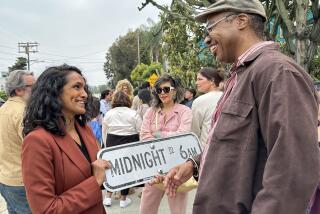Race Is On to Get Gay Network on the Air in U.S.
- Share via
Just five years after Ellen DeGeneres shattered stereotypes as the first openly gay lead character in a television sitcom, attitudes have changed so dramatically that media companies are laying the groundwork to launch cable networks devoted to gay viewers.
Unlike the almost routine presence of gay characters on mainstream television these days, the new networks would focus exclusively on gay lifestyles with shows about fitness, travel, politics and even explicit sex.
The efforts of media giant Viacom Inc. and the Canadian channel PrideVision reflect the growing acceptance of gay programming and the increasing demand for new shows to fill up hundreds of digital cable channels.
PrideVision debuted in Canada in September, and its operators are shopping for distribution and funding in the United States. Viacom announced this year that its MTV and Showtime divisions are exploring a joint effort to create a gay network.
Marketers covet gay audiences because they are believed to have more disposable income than other viewers and be more willing to spend it on entertainment. Still, the race to launch a 24-hour-a-day gay channel astounds veteran gay activists.
“Thirty years ago it would have taken a civil rights action to get something like this started. Now it’s a business decision,” said author Malcom Boyd. “I never thought in my lifetime I would see anything like this.”
It took mainstream networks to show the way. ABC was picketed after DeGeneres came out on her show. But NBC’s “Will & Grace” is a hit with straight and gay viewers alike. Likewise, Showtime’s “Queer as Folk” and HBO’s “Six Feet Under.”
“For networks, a lot of it has to do with the lowering of the fear threshold about gay content,” said Larry Gross, author of “Up From Invisibility: Lesbians, Gay Men and the Media in America.”
“The shows got on and the Earth did not open up and swallow them up. The peasants with pitchforks did not march on the studios.”
Although welcomed by gay viewers, PrideVision does little to quell the stereotype of gay men as fitness-obsessed, sex-crazed partyers who swoon over Barbra Streisand. Indeed, its shows, with names such as “SoGay TV,” “Bump!” and “Locker Room,” feature lots of innuendo and flesh. After midnight, the channel shows sexually explicit programs, alternating between “Frisky Femmes” and “Steamy Knights.”
Viacom has divulged little about its plans.
Even with the growing acceptance of gay programming on television, some conservative groups in the United States have vowed to oppose any all-gay network. Unlike similar cable networks targeting a particular audience--such as Lifetime for women and Black Entertainment Television for African Americans--the prospect of a gay channel still inspires condemnation from some.
L. Brent Bozell, president of the Parents Television Council, wrote in January that the creation of a gay cable channel “is not some kind of affirmative-action proposal to bring gays into Hollywood. They’re there, at every level, already. This is a move to promote the homosexual lifestyle to the public.”
Some U.S. residents want their gay TV so badly that they have circumvented federal law by purchasing Canadian satellite receivers and established fake Canadian mailing addresses to sign up for PrideVision, which is owned by Headline Media Group Inc. and counts 18,000 subscribers who pay about $7.50 a month for the channel. Headline Chief Executive John Levy said the channel needs 245,000 subscribers to break even.
That’s a tiny audience by traditional broadcast standards. But in the new world of digital cable and satellite service, it’s possible for networks to be profitable with a small audience. PrideVision has guaranteed distribution on Canadian cable and satellite systems. It’s negotiating with U.S. operators, but has yet to secure a deal.
Although a pay channel, PrideVision supplements its income with advertising. Levy said the advertising was needed to help pay for original programming. Early niche channels such as Lifetime were able to buy programming. But the dearth of gay shows meant PrideVision had to produce its own.
“We had to have programs specifically by and for the ... audience to do a pay, 24-hour-a-day channel,” Levy said. “There was just not that much out there we could pick up in the way of gay programming directly for a gay audience.”
Programming will make or break a niche pay channel.
“A novelty will take you just so far,” said industry analyst Derek Baine of Kagan World Media.
Baine said he would be “a lot more bullish” on Viacom if the two companies try to launch networks simultaneously. But Michael Thorton, who heads acquisition for satellite service DirecTV, said he has met with PrideVision and Viacom and might carry both channels.
Jason, a 28-year-old Santa Monica resident who did not want his last name used because he receives PrideVision illegally, said he is a big fan of the channel.
“The travel show ‘Bump!’ is my favorite, and I like ‘SoGay TV,’ which gets into serious topics and sometimes real risque topics. And they have a lot of eye candy.”
The eye candy is mostly male and buff. Although some PrideVision shows address serious matters, many of the programs, no matter what the subject matter, feature young men with at least their shirts off. Even a segment on the “Locker Room” at a gay ski event featured a guy on the snow with chest bare and muscles bulging.
“I think you can count on that being the case with Showtime too if that channel happens,” said Gross, who teaches at the University of Pennsylvania. “There is no question eye candy is going to be a major ingredient. Just look on any newsstand--this culture is drenched in it.”
Suzanna Walters, author of the book, “All the Rage--The Story of Gay Visibility in America,” has seen PrideVision shows and was disappointed by the lack of sexual, race and age diversity. But she understands the economic underpinnings of the choice.
“When they think of the gay person with disposable income, they think of the young, white, urban male with no children. So, you are probably not going to see much of a black lesbian single parent.”
But, she said, “I guess that having some version of yourself portrayed is better than nothing at all. And it does get away from some of the old stereotypes. I’d rather be considered a niche of a niche market than portrayed as a killer prison matron from hell.”
More to Read
The biggest entertainment stories
Get our big stories about Hollywood, film, television, music, arts, culture and more right in your inbox as soon as they publish.
You may occasionally receive promotional content from the Los Angeles Times.











